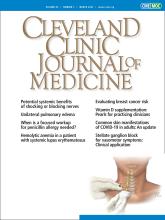Article Figures & Data
Tables
Patient characteristics Minimum requirement Commentsa Age 19–50 600 IU/day Increasing and maintaining the 25(OH)D level consistently above 30 ng/mL may require at least 1,500–2,000 IU/day Age 51–70 600 IU/day To maximize bone health and muscle function Age ≥ 65 800 IU/day For the prevention of falls and fractures Pregnant and lactating female patients 600 IU/day At least 1,500–2,000 IU/day may be needed to maintain a blood level of 25(OH)D above 30 ng/dL Adults with obesity Give at least 2 to 3 times more vitamin D to meet bodily requirements ↵a With the recommendation not to exceed 4,000 IU daily maintenance dose.
IU = international units; 25(OH)D = 25-hydroxyvitamin D
Based on information in reference 10.
Food Micrograms per serving International units per serving Percent of daily valuea Cod-liver oil, 1 tablespoon 34.0 1,360 170 Trout (rainbow), farmed, cooked, 3 ounces 16.2 645 81 Salmon (sockeye), cooked, 3 ounces 14.2 570 71 Mushrooms, white, raw, sliced, exposed to ultraviolet light, ½ cup 9.2 366 46 Milk, 2% milkfat, vitamin D fortified, 1 cup 2.9 120 15 Soy, almond, and oat milks, vitamin D fortified 2.5–3.6 100–144 13–18 Ready-to-eat cereal, fortified with 10% of the daily valuea for vitamin D, 1 serving 2.0 80 10 Sardines (Atlantic), canned in oil, drained, 2 sardines 1.2 46 6 Egg, 1 large, scrambledb 1.1 44 6 Liver, beef, braised, 3 ounces 1.0 42 5 Tuna (light), canned in water, drained, 3 ounces 1.0 40 5 Cheese, cheddar, 1 ounce 0.3 12 2 ↵a Daily value (DV) was developed by the US Food and Drug Administration to help consumers compare the nutrient contents of foods and dietary supplements within the context of a total diet. The DV for vitamin D is 20 μg (800 IU) for adults and children age 4 years and older. Foods providing 20% or more of the DV are considered to be high sources of a nutrient, but foods providing lower percentages of the DV also contribute to a healthful diet.
↵b The vitamin D is in the yolk.
Based on information in reference 1.






